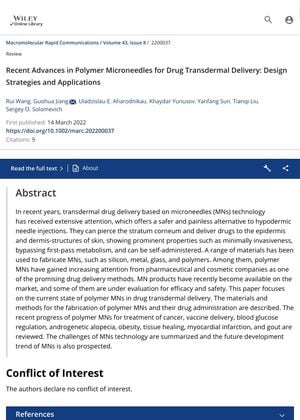Recent Advances in Polymer Microneedles for Drug Transdermal Delivery: Design Strategies and Applications
March 2022
in “
Macromolecular Rapid Communications
”

TLDR Polymer microneedles are a promising, painless alternative to traditional needles for delivering drugs through the skin.
The review discusses the recent advancements in the use of polymer microneedles (MNs) for transdermal drug delivery. MNs technology, which provides a safer and painless alternative to hypodermic needle injections, has gained significant attention. These microneedles can pierce the skin's stratum corneum and deliver drugs to the epidermis and dermis, offering benefits like minimal invasiveness, bypassing first-pass metabolism, and self-administration. Among various materials used to create MNs, polymer MNs have gained increased interest from pharmaceutical and cosmetic companies. The paper describes the materials and methods for fabricating polymer MNs and their drug administration. It also reviews the recent progress of polymer MNs in treating various conditions, including cancer, vaccine delivery, blood glucose regulation, androgenetic alopecia, obesity, tissue healing, myocardial infarction, and gout. The challenges and future development trends of MNs technology are also discussed.


